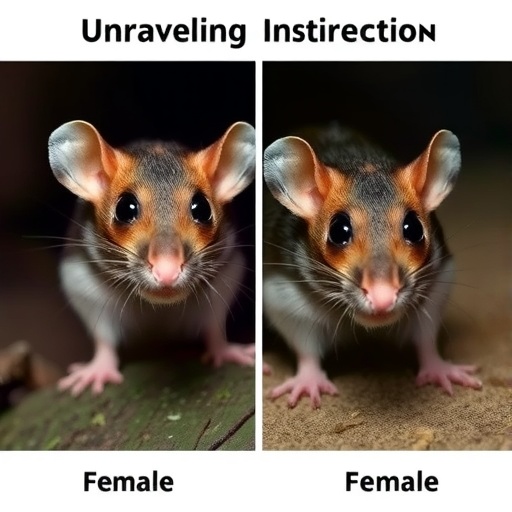In recent years, the complex interplay between biological systems and behavior has become a focal point for neuroscientific research, especially in the context of fear and anxiety-related disorders. A groundbreaking study published in Translational Psychiatry in 2025 by Ten-Blanco et al. sheds new light on the intricate mechanisms that regulate fear extinction, a process critical to overcoming traumatic memories. By combining cutting-edge approaches such as HPA axis analysis, gut microbiota profiling, and transcriptomic sequencing, this research unravels the biological underpinnings of individual differences in fear extinction, highlighting important sex-specific variations in male and female mice.
Fear extinction—the gradual reduction of a conditioned fear response—is vital for adaptive behavior and mental health. Deficits in this process are implicated in conditions such as PTSD, anxiety disorders, and phobias. While prior studies have identified broad neural circuits involved in fear extinction, the biological factors influencing individual variability remain poorly understood. The study by Ten-Blanco and colleagues addresses this gap by exploring how endocrine, microbial, and genetic factors converge to influence extinction capacity differently across sexes.
Central to their investigation is the hypothalamic-pituitary-adrenal (HPA) axis, a neuroendocrine system that governs stress responses through the release of glucocorticoids like corticosterone in rodents. The authors measured HPA axis activity during fear extinction sessions, revealing that male and female mice exhibit distinct patterns of hormone secretion. These differences corresponded to varying extinction rates, suggesting that the timing and magnitude of corticosterone release modulate how effectively fear memories are diminished.
Beyond hormonal influences, the study harnessed the burgeoning field of microbiome research to examine gut bacterial populations, which have emerged as critical players in brain function via the gut-brain axis. Detailed microbial community profiling revealed sex-specific signatures correlating with fear extinction proficiency. Notably, certain bacterial taxa that produce neuroactive metabolites were more abundant in individuals exhibiting robust extinction, implicating gut microbes as modulators of neural plasticity underlying fear learning.
To deepen the mechanistic understanding, the researchers employed transcriptomic analyses of brain regions implicated in fear processing, such as the amygdala and prefrontal cortex. By sequencing RNA transcripts, they identified gene expression patterns linked to extinction success. Strikingly, gene networks involved in synaptic transmission, neuroinflammation, and stress hormone signaling displayed sex-dependent regulation. This genomic perspective illuminated how males and females mobilize distinct molecular pathways to achieve fear attenuation.
The integrative approach of this study exemplifies modern neuroscience’s shift toward systems biology, where multiple physiological layers are analyzed concurrently to capture the complexity of behavior. By bridging endocrinology, microbiology, and genomics, Ten-Blanco et al. provide a multidimensional map of fear extinction biology. Their findings underscore that any effective therapeutic strategy for anxiety disorders must consider these intertwined factors and sex differences to enhance treatment efficacy.
Moreover, this research highlights the importance of studying both male and female subjects, as most prior fear extinction studies predominantly used male animals, potentially overlooking fundamental sex-specific variables. The documented variations in HPA axis dynamics, microbial composition, and gene expression profiles between sexes contribute to the growing recognition that biological sex profoundly influences brain function and mental health outcomes.
The implications of this work extend into clinical realms. Understanding the mechanisms driving individual differences in fear extinction can inform personalized medicine approaches, including the development of microbiota-targeting interventions or hormone modulation therapies. For example, manipulating gut bacteria through probiotics or diet could offer novel anxiolytic strategies tailored to one’s biological sex and stress hormone profile.
Furthermore, the study opens avenues for biomarker discovery. Molecular signatures uncovered in the transcriptomic data might serve as predictive markers for extinction capacity, which could guide clinicians in identifying patients at risk for chronic fear-related disorders or those likely to respond to cognitive-behavioral therapies that rely on extinction principles.
On a broader scale, the interplay between the HPA axis, gut microbiota, and brain gene expression exemplifies the emerging paradigm of psychoneuroimmunology and neuroendocrinology intersecting with microbial ecology. This holistic view prompts researchers to move beyond reductionist models and appreciate the body’s interconnected systems as dynamic contributors to mental health and disease.
In delineating these biological pathways, the authors also emphasize future directions, suggesting longitudinal studies tracking how these factors evolve across development and in response to environmental challenges. This temporal dimension is crucial as plasticity in stress systems and microbiota composition can profoundly influence lifelong trajectories of emotional regulation.
Technological advances, such as single-cell RNA sequencing and metagenomics, promise to add further granularity by identifying specific cell types involved in fear circuits and pinpointing microbe-host interactions at molecular resolution. Incorporating such methods will refine our understanding of the cellular and microbial actors orchestrating fear extinction.
The interdisciplinary nature of this research spotlights the need for collaborative efforts spanning neuroscience, endocrinology, microbiology, and computational biology. Such synergies will accelerate the translation of basic science findings into clinical applications, ultimately improving outcomes for individuals suffering from debilitating anxiety disorders.
Ten-Blanco et al.’s study stands as a testament to the power of multifaceted inquiry to decode the biological complexity of behavior. By elucidating the sex-specific mechanisms that govern fear extinction through integrated analysis of the HPA axis, gut microbiota, and transcriptomics, they lay a foundation for innovative, personalized treatments that acknowledge individual biological identities.
As anxiety and trauma-related disorders continue to rise globally, insights from this research offer hope for more effective interventions that harness the body’s natural regulatory systems. The convergence of hormonal, microbial, and genetic factors presents a rich tapestry upon which the future of psychiatric neuroscience will be woven, promising breakthroughs that resonate well beyond the laboratory.
Subject of Research: Individual differences in fear extinction mechanisms in male and female mice, focusing on HPA axis function, gut microbiota, and transcriptomic profiles.
Article Title: Exploring individual differences in fear extinction in male and female mice: insights from HPA axis, microbiota, and transcriptomics.
Article References:
Ten-Blanco, M., Ponce-Renilla, M., Pereda-Pérez, I. et al. Exploring individual differences in fear extinction in male and female mice: insights from HPA axis, microbiota, and transcriptomics. Transl Psychiatry 15, 195 (2025). https://doi.org/10.1038/s41398-025-03400-9
Image Credits: AI Generated




